Menus
- What you must remember
- Themore
- Theless
- Prices
- Make yourKawasaki Ninja 400 2019
- Opinion
- Replaces
- Performances
- The technical aspect
- Competitors
- Gallery
- Related articles
THEhen the likeable Ninja 250 R appeared in 2008, it hardly suffered from competition in a category not common in Europe. Then the Ninja 300 R took over in 2013 and saw the arrival in its fold of other baby-sportsmen (Yamaha YZF-R3, the KTM RC 390, Suzuki GSX 250 R, Honda CBR 300 R) initially intended for emerging countries but that the new driving license rules (thank you the A2 license *) have greatly brought back the spotlight to make it an ultra-competitive category. It was therefore without fear that we learned of the disappearance of the Ninja 300 from the catalog in 2017. It was indeed certain that Kawa would quickly return to the fight. After a blank year, it is therefore in 2018 that the mini-Ninja tightens its muscles and shows us its new vintage: the Ninja 400.
And in view of the result, we can easily forgive the Japanese engineers for having missed out on 2017. Power, braking, chassis, finish…. Everything has been improved in this new low-size Ninja. And if we add a slimming cure and a facelift with KRT sauce, all the ingredients are there to continue the operation to seduce his fun and sparkling mini-sports.
Ninja 400 did we say? Yes, because its parallel twin has gained 100 cm3 of displacement and now tops out at a cube that echoes a past generation: Does the ZXR 400 R from 1990 speak to you? But stop. The comparison ends there: 15 years ago, it was an in-line 4 cylinder that baled 65 horsepower. Today the twin cylinder inflated to 399cm announces 45 ponies… ..is 6 better than the Ninja 300. More power but also more torque. This will also be available earlier since Kawa announces 38 Nm at 8,000 rpm against 27 at 10,000, i.e. a significant gain of 11 Nm..
These increased performances have however been studied for a more “friendly” handling. Thus the engine response is announced smoother and predictable without sacrificing the feeling of power. What better way to start and have fun without putting yourself in danger.
Kawasaki has designed this new engine with as much care as the larger displacement mills. A lot of work has been done on the air intake. The flow has been optimized and the air box has seen its volume increase (5.8 L for 4.7 before) to facilitate the taking of turns. The left and right intake vents are different heights to help provide smoother engine response and to reduce torque dips.
In addition, the machine will be fitted with the dual-cam “Assist & Slipper” clutch to soften the clutch grip and prevent the rear wheel from jamming in the event of a violent downshift..
Overall the engine has been designed to be as compact as possible so that its weight and size are almost identical to those of the Ninja 300cm3.
Other solutions also made it possible to reduce the weight of the bike (lighter frame and swingarm, forged camshafts, compact clutch, reduced amount of fluid carried, lighter exhaust). The Ninja 400 loses 8 kg and announces 168 kg against 176 kg for the one it replaces. One of the welcome little frills is the new patented system that places the fan behind the radiator and allows hot air to be vented away from the rider to avoid big flashes of heat in traffic jams. The other advantage is to limit the insulating parts to save precious grams.
If the engine is new, it is the same for the tubular trellis frame inspired by that of the Ninja H2 (as for the Ninja 650) and which ensures better rigidity without weighing down the machine. Another similarity with the H2, the swingarm is directly connected to the engine which therefore has an essential role in the rigidity of the motorcycle. This allows for a long arm while retaining a reduced wheelbase of 1370mm for more maneuverability and stability. On the peripheral side, the 41 mm diameter telescopic fork is stiffened and the caster angle is more closed, which should improve precision compared to the Ninja 300. For the rear suspension, the Ninja retains an adjustable mono-shock absorber. in prestressing.
As for the wheels, it adopts 5-spoke star rims similar to that of the Ninja 650. These will be shod with Dunlop Sportmax GPR-300 with a versatile profile. Sign that the Ninja is gaining ground, the rear gommard goes from 140 to 150 mm.
For braking, the front will be slowed down by a 310mm semi-floating petal disc (like the ZZR 1400! – but it has 2) and bitten off by a two-piston caliper. Rear braking is entrusted to a 220mm petal disc and has a two-piston caliper. The standard ABS is managed by the Nissin console announced as the most compact and light on the market.
The driving position remains sporty but not radical. The saddle height of 785 mm and the slimmer front of 30 mm will allow smaller riders to still easily put their feet on the ground. The design has also evolved. Inspired by the ZX 10-R, he doesn’t forget to wink at the H2 which seems to have become the master stallion of sportiness at Kawa. The design of the Ninja 400 is gaining strength. In profile, we notice a less frowning front face with a more raised nose and a frank look. The affiliation with the H2 is underlined by the two small spoilers which take place under each headlight. Ditto for the rear seat. A sign of increasing quality, the manufacturer announces more painted parts while the indicators remain integrated into the fairing sides. All front / rear lighting is full LED.
For instrumentation too, it has everything a great! This Ninja 400 inherits the dashboard of the Ninja 650 with its needle tachometer framed on the left by an indicator bar and on the right by a large multifunction LCD screen. The gear indicator engaged is therefore part of the game and only the shift-light disappears during the transplant. If the tank contains only 14 liters (against 17 previously), the autonomy of the machine remains estimated at 350 km in particular. thanks to weight gain.
As you will have understood, this small motorcycle has all the ingredients to enjoy the virolos of our small country roads without risking losing your license at the slightest straight line ….
* the A2 regulation, implies having a machine not exceeding 47.6 horsepower (35 kW), which cannot be the result of a clamping from a base making more than 95 horsepower (70 kW) and which does not must not have a power to weight ratio of more than 0.2 kW per kg.
What you must remember
Themore
Theless
Prices
6,199 €
Price
nine
Compare
the credits
Make
yourKawasaki Ninja 400 2019
Estimate, calculate and compare the cost of insuring your motorcycle.
Calculate the cost of
insurance
Test the price of the motorcycle insurance specialist
Opinion
on 5 opinion
users
Read the reviews
Replaces
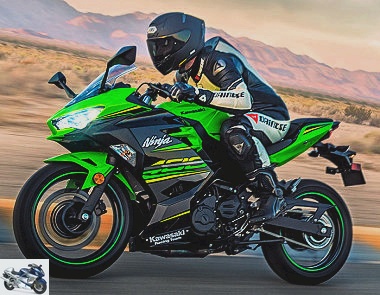
Ninja 400 2018
Model marketed in
2018
2019
2020
Performances
-
Max speed:
about 170 km / h
The technical aspect
Kawasaki Ninja 400 2019
- Frame
- Frame: Structure in steel tubes
- Tank: 14 liters
- Seat height: 785 mm
- Length: 1,990 mm
- Width: 710 mm
- Height: 1120 mm
- Wheelbase: 1370 mm
- Weight in running order: 168 kg
- Train before
- Telescopic fork Ø 41 mm, deb: 120 mm
- 1 disc Ø 310 mm, 2 piston caliper
- Front wheel:
110/70
– 17
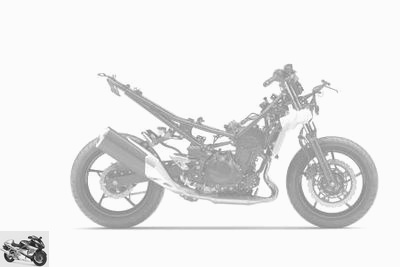
- Transmission
- 6-speed gearbox
- secondary by chain
- Rear axle
- Mono-shock absorber, deb: 130 mm
- 1 disc Ø 220 mm, 2 piston caliper
- Rear wheel:
150/60
– 17
- Motor
- Twin cylinder
parallel
, 4 stroke - Cooling: by water
- Injection Ø 32 mm
- 2 ACT
- 4 valves per cylinder
-
399 cc
(70 x 51.8 mm) -
45
ch
at 10,000 rpm -
3.90 mkg
at 8000 rpm - Compression: 11.5: 1
- Crit’air:
Detached pieces
exhaust
motor
fluid
electricity
filtration
braking
chain kit
Competitors
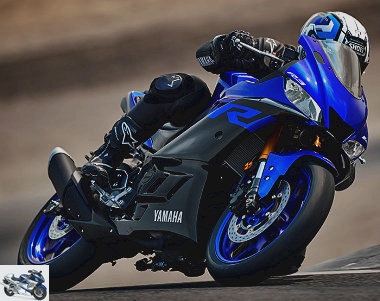
2019 Yamaha YZF-R3 300
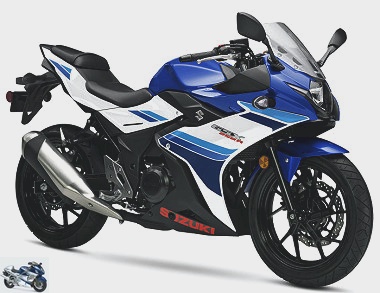
Suzuki GSX 250 R 2019
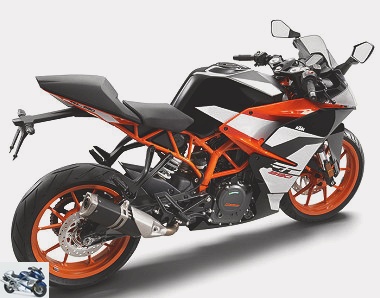
2019 KTM RC 390
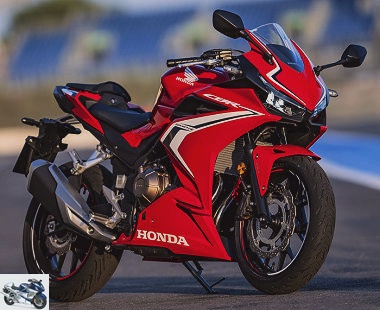
2019 Honda CBR 500 R
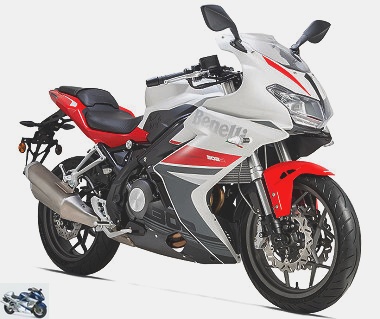
2019 Benelli 302 R
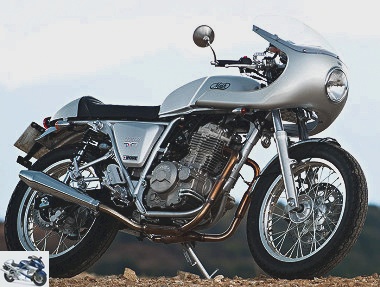
Mash 400 TT40 Cafe Racer 2019
Gallery
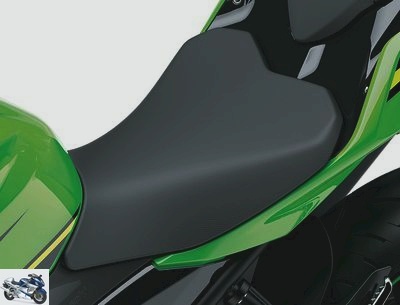
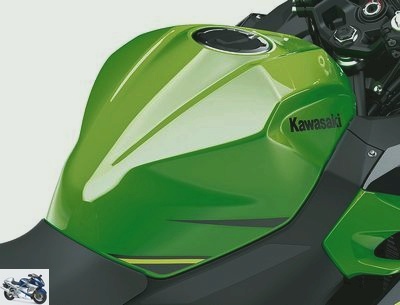
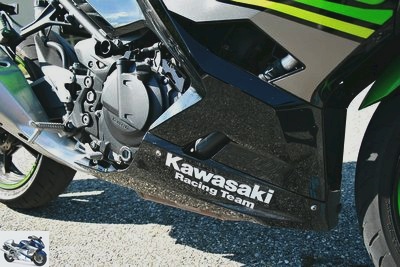


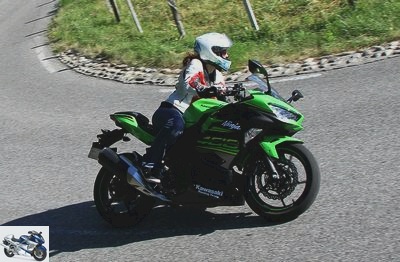
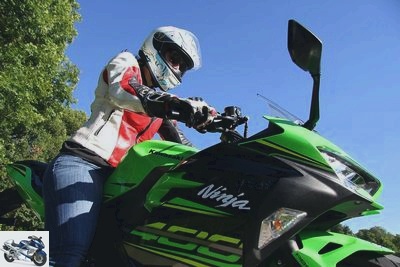
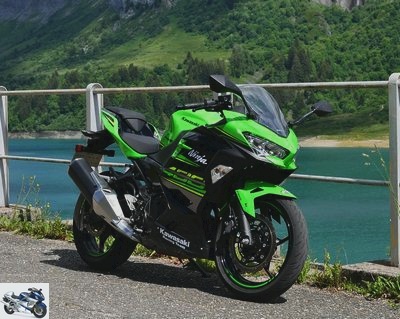
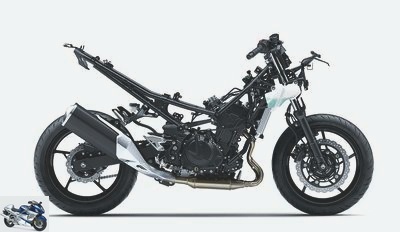
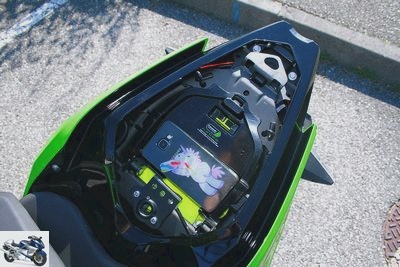
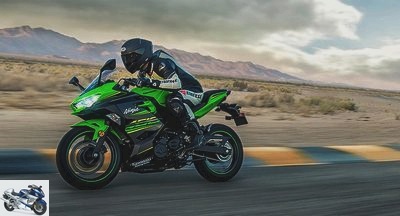

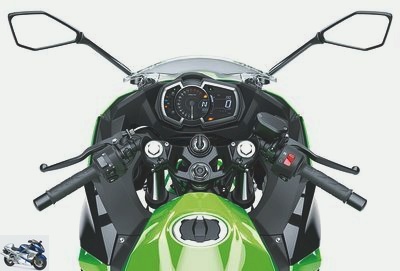
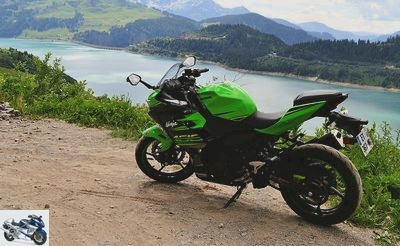
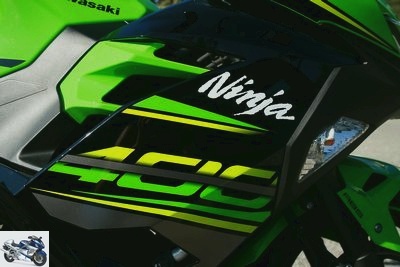
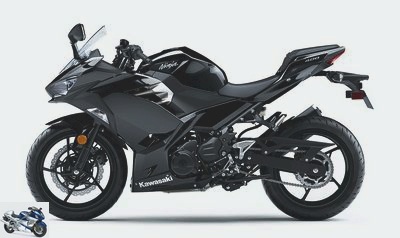

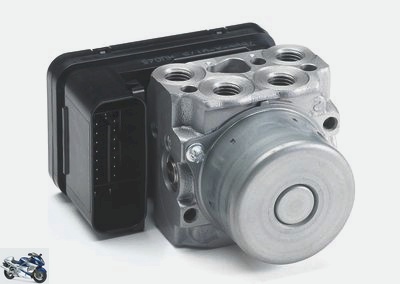
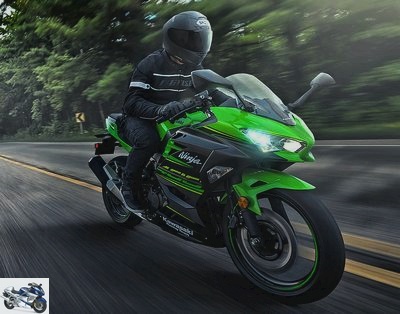
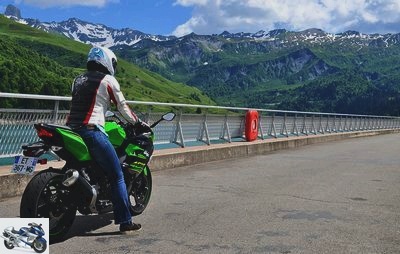
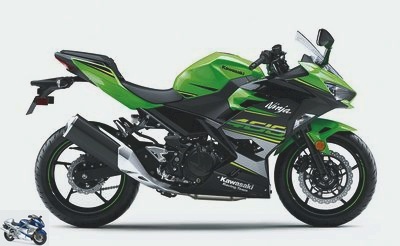

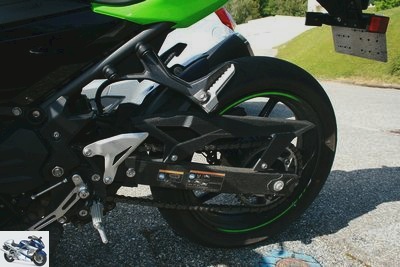
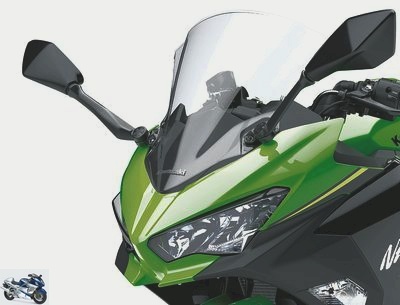
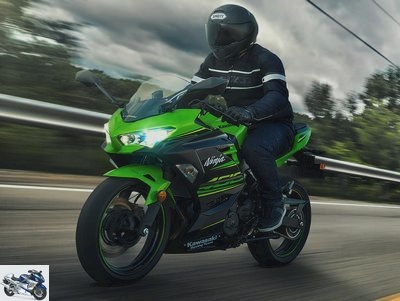
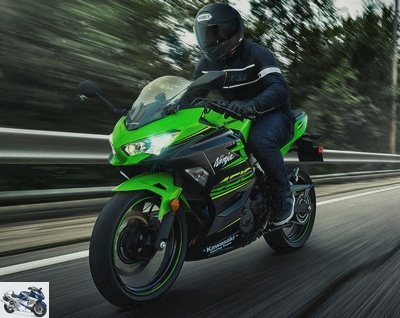
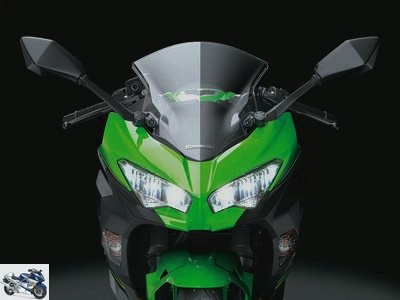
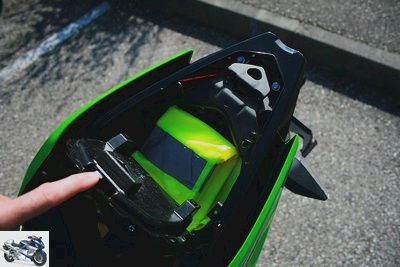
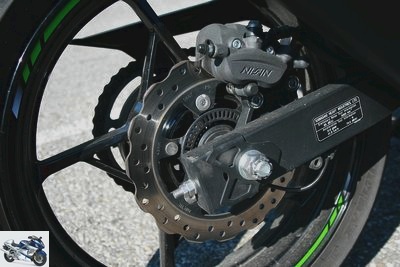
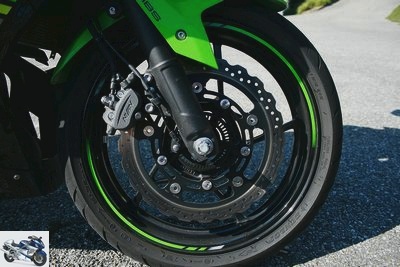
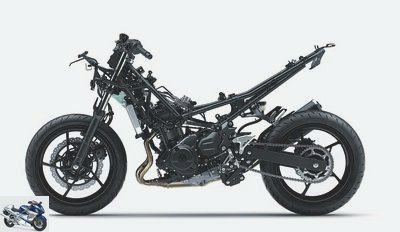
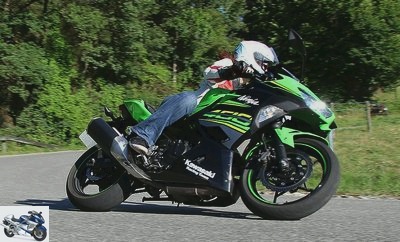
Related articles
-
THE hen the likeable Ninja 250 R appeared in 2008, it hardly suffered from competition in a category not common in Europe. Then the Ninja 300 R took over…
-
THE hen the likeable Ninja 250 R appeared in 2008, it hardly suffered from competition in a category not common in Europe. Then the Ninja 300 R took over…
-
The Versys concept takes on another dimension with this small displacement. The first of the name, appeared in 2007 with 650 cm3, took Kawasaki to the…
-
Serious optimization step for the big cross country of Kawa in 2019. A KX 450, that only thinks of one thing, to claim the podium; and especially the…
-
The A2 license is like diapers, getting dumped or having a first m … job: you have to go through it, and there is no choice. Not a reason either for it…
-
Kawasaki Ninja 650 ?! Could this be Akashi’s new supersport? The ZX-6R would have survived the genocide operated in its category ?? Not quite. Under this…
-
The last sports car that Kawa marketed in the 125cc clan, when was it? End of the 80s, with the 125 AR? Was there any after? Not sure. The brand is…
-
It’s still no luck. While the Vintage movement confirmed its rise, the Euro4 standards came to sabotage the survival of the W 800. It which perfectly…
-
What facies! During its 2015 evolution, the Kawasaki 650 Versys has given itself a new face … and that it suits it damn well. From its appearance in…
-
All superlatives have been used to define H2R. Some minor changes will thus have difficulty finding an echo in the aura of this exceptional motorcycle….